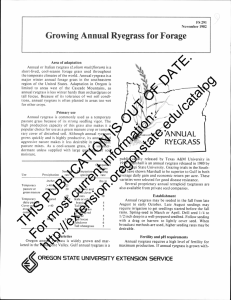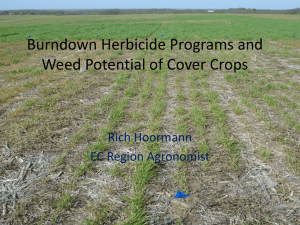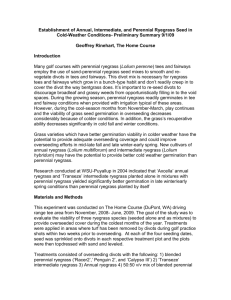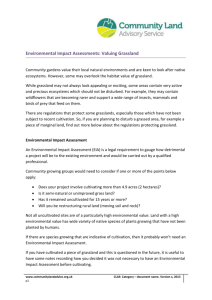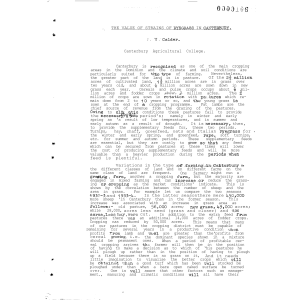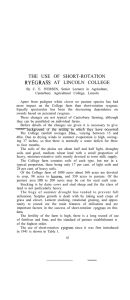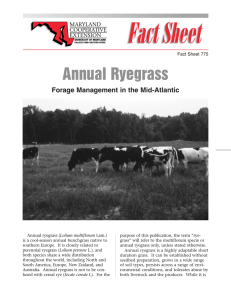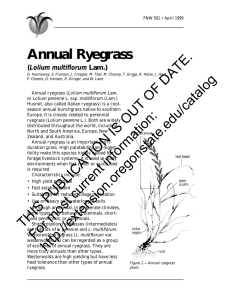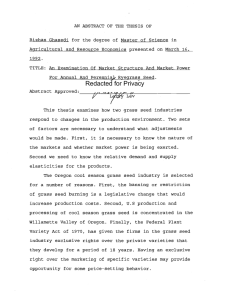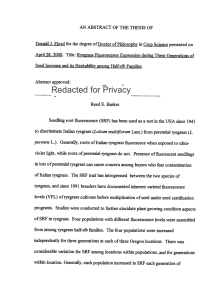Document 10904896
advertisement
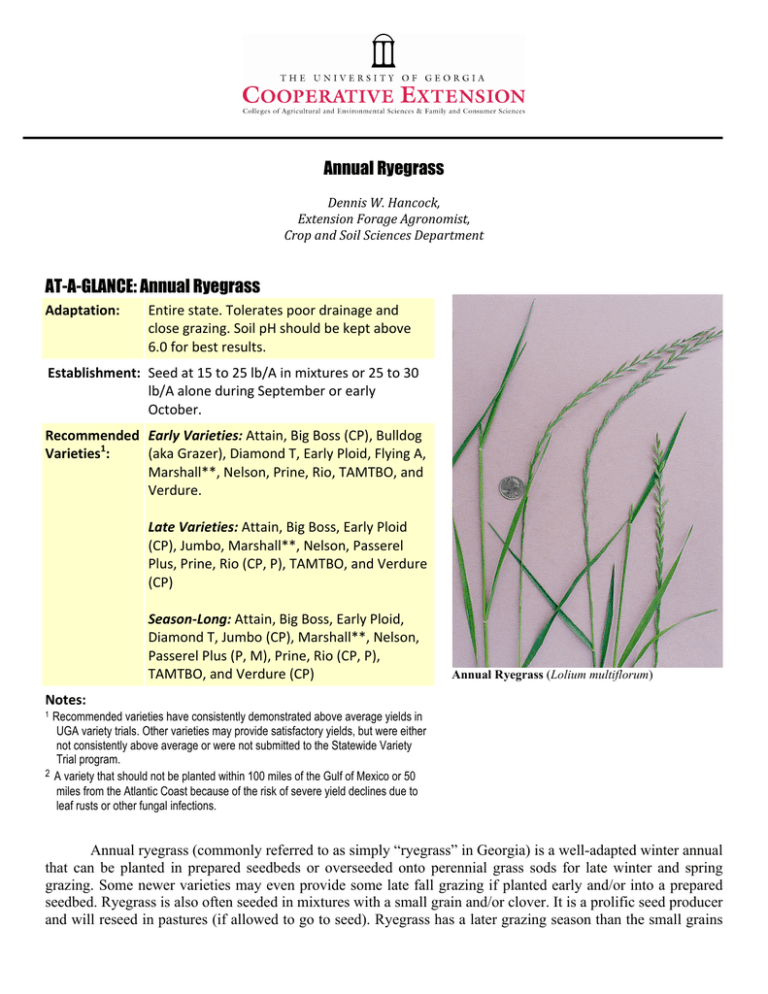
Annual Ryegrass Dennis W. Hancock, Extension Forage Agronomist, Crop and Soil Sciences Department AT-A-GLANCE: Annual Ryegrass Adaptation: Entire state. Tolerates poor drainage and close grazing. Soil pH should be kept above 6.0 for best results. Establishment: Seed at 15 to 25 lb/A in mixtures or 25 to 30 lb/A alone during September or early October. Recommended Early Varieties: Attain, Big Boss (CP), Bulldog Varieties1: (aka Grazer), Diamond T, Early Ploid, Flying A, Marshall**, Nelson, Prine, Rio, TAMTBO, and Verdure. Late Varieties: Attain, Big Boss, Early Ploid (CP), Jumbo, Marshall**, Nelson, Passerel Plus, Prine, Rio (CP, P), TAMTBO, and Verdure (CP) Season-­‐Long: Attain, Big Boss, Early Ploid, Diamond T, Jumbo (CP), Marshall**, Nelson, Passerel Plus (P, M), Prine, Rio (CP, P), TAMTBO, and Verdure (CP) Annual Ryegrass (Lolium multiflorum) Notes: Recommended varieties have consistently demonstrated above average yields in UGA variety trials. Other varieties may provide satisfactory yields, but were either not consistently above average or were not submitted to the Statewide Variety Trial program. 2 A variety that should not be planted within 100 miles of the Gulf of Mexico or 50 miles from the Atlantic Coast because of the risk of severe yield declines due to leaf rusts or other fungal infections. 1 Annual ryegrass (commonly referred to as simply “ryegrass” in Georgia) is a well-adapted winter annual that can be planted in prepared seedbeds or overseeded onto perennial grass sods for late winter and spring grazing. Some newer varieties may even provide some late fall grazing if planted early and/or into a prepared seedbed. Ryegrass is also often seeded in mixtures with a small grain and/or clover. It is a prolific seed producer and will reseed in pastures (if allowed to go to seed). Ryegrass has a later grazing season than the small grains and can be grazed until early May in south Georgia and late May or early June in north Georgia when moisture is adequate. Ryegrass is one of the highest quality forages that can be grown in Georgia, often providing over 70% TDN and 18% CP if grazed in the late vegetative stage. High quality (56-64% TDN and 10-16% CP) can also be expected in the early stages of seedhead development. However, quality and palatability of late season forage can be low due to disease (mainly rust) and maturity. Since it can produce such high quality when properly managed, it often is planted for high quality hay or silage cuttings (usually 1 or 2) in the spring. It is also commonly planted into dormant bermudagrass hayfields. This is a recommended practice, but the ryegrass should be mowed, cut for hay, or grazed before the bermudagrass comes out of dormancy. This harvesting of ryegrass should be timed (usually late March in south Georgia and late April in north Georgia) so as to prevent the ryegrass from suppressing the spring emergence of bermudagrass. Hay harvests in late April or May are often difficult because of rainfall. Care should be taken to ensure that ryegrass is dried to a moisture level that is appropriate for safe storage of hay (15% moisture for round bales; 18% moisture for square bales). Alternatively, ryegrass haylage and baled silage can be used to conserve this high quality forage when rainfall is of concern. Establishment of Annual Ryegrass Establish annual ryegrass on well-drained, fertile soils when possible. If the sites are somewhat poorlydrained, ryegrass will be a better choice than the small grains. Treat small grain seed with an approved fungicide prior to planting. Seedling diseases such as Phytophthora, Rhizoctonia, Pythium, and others reduce stands when planted in the warmer months of September and October, especially in south Georgia. Annual ryegrass can be seeded between late August and early October in the Limestone Valley/Mountains region, early September and mid- to late October in the Piedmont region, and late September to late October in the Coastal Plain region. If late fall and early winter grazing is desired (lower Piedmont and Coastal Plain regions only), plant at the earlier dates of these ranges and into a prepared seedbed. Do not overgraze these pastures during the late fall or early winter. For best results, maintain at least 2 ½ in. of stubble height. If planting into a prepared seedbed, prepare the seedbed two to three weeks before planting, if practical. This will allow the soil to settle and firm, thus improving seed germination and seedling development. Although deep soil preparation is not necessary for the grazing crop, deep tillage may benefit row crops planted in the spring. Seed can be placed more precisely with a drill or cultipacker seeder than by broadcasting and disking. When seed are broadcast, increase the seeding rate by 25 – 30% to allow for variable seed placement. Plant small grain seed 1 – 1 ½ in. deep in moist soil. Do not plant ryegrass seed deeper than ½ in. When planting mixtures of ryegrass and small grains, it may be easier to control the seeding depth of these species by broadcasting ryegrass seed and then drilling the small grain seed into the seedbed. Apply 40 – 50 lbs of N per acre at planting or soon after the plants emerge to increase growth, tillering (thickening of the stand), and provide earlier grazing. A second application of 40 – 50 lbs of N per acre should be applied in mid-winter to increase winter and spring forage production. Because ryegrass is longer-lived, a third application of 40 – 50 lbs of N per acre may be needed in early spring when ryegrass is used for late spring grazing, hay, or silage crop. Rates of N in excess of these amounts may result in substantial N losses to leaching and excessive growth during the winter. Fresh, tender growth that occurs when nitrogen is in excess could be damaged by extremely cold weather. The University of Georgia and Ft. Valley State University, the U.S. Department of Agriculture and counties of the state cooperating. Cooperative Extension, the University of Georgia College of Agricultural and Environmental Sciences, offers educational programs, assistance and materials to all people without regard to race, color, national origin, age, gender or disability. An Equal Opportunity Employer/Affirmative Action Organization Committed to a Diverse Work Force CSS-­F012 Revised July 2011 Issued in furtherance of Cooperative Extension work, Acts of May 8 and June 30, 1914, The University of Georgia College of Agricultural and Environmental Sciences and the U.S. Department of Agriculture cooperating. J. Scott Angle, Dean and Director.
